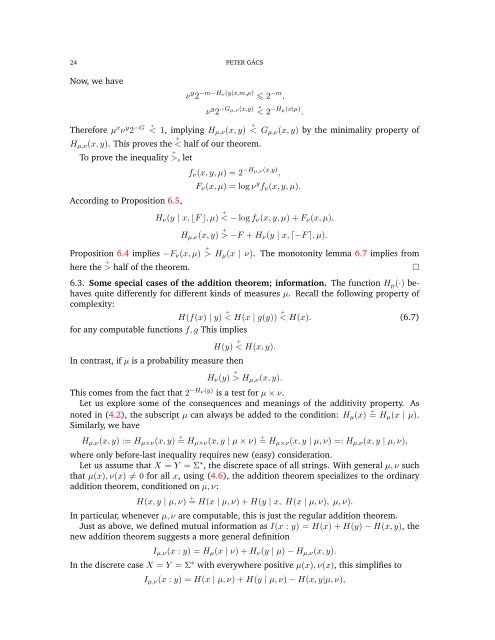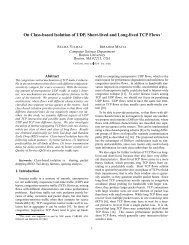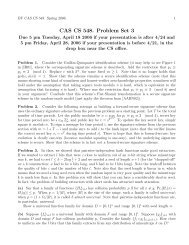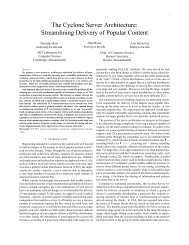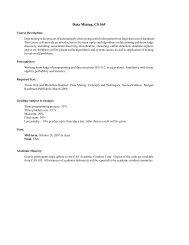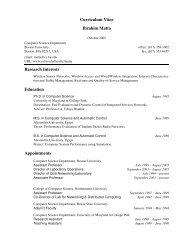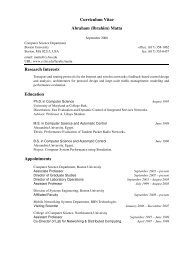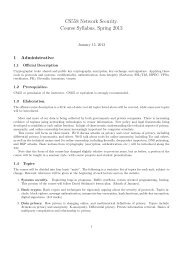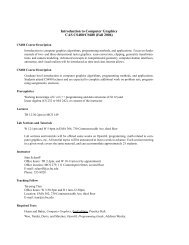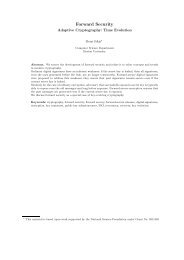uniform test of algorithmic randomness over a general ... - CiteSeerX
uniform test of algorithmic randomness over a general ... - CiteSeerX
uniform test of algorithmic randomness over a general ... - CiteSeerX
You also want an ePaper? Increase the reach of your titles
YUMPU automatically turns print PDFs into web optimized ePapers that Google loves.
24 PETER GÁCS<br />
Now, we have<br />
ν y 2 −m−Hν(y|x,m,µ) 2 −m ,<br />
Therefore µ x ν y 2 −G<br />
ν y 2 −Gµ,ν(x,y) ∗ < 2 −Hµ(x|µ) .<br />
∗<br />
< 1, implying H µ,ν (x, y) + < G µ,ν (x, y) by the minimality property <strong>of</strong><br />
H µ,ν (x, y). This proves the + < half <strong>of</strong> our theorem.<br />
To prove the inequality + >, let<br />
According to Proposition 6.5,<br />
f ν (x, y, µ) = 2 −Hµ,ν(x,y) ,<br />
F ν (x, µ) = log ν y f ν (x, y, µ).<br />
H ν (y | x, ⌊F ⌋, µ) + < − log f ν (x, y, µ) + F ν (x, µ),<br />
H µ,ν (x, y) + > −F + H ν (y | x, ⌈−F ⌉, µ).<br />
Proposition 6.4 implies −F ν (x, µ) + > H µ (x | ν). The monotonity lemma 6.7 implies from<br />
here the + > half <strong>of</strong> the theorem.<br />
6.3. Some special cases <strong>of</strong> the addition theorem; information. The function H µ (·) behaves<br />
quite differently for different kinds <strong>of</strong> measures µ. Recall the following property <strong>of</strong><br />
complexity:<br />
H(f(x) | y) + < H(x | g(y)) + < H(x). (6.7)<br />
for any computable functions f, g This implies<br />
In contrast, if µ is a probability measure then<br />
H(y) + < H(x, y).<br />
H ν (y) + > H µ,ν (x, y).<br />
This comes from the fact that 2 −Hν(y) is a <strong>test</strong> for µ × ν.<br />
Let us explore some <strong>of</strong> the consequences and meanings <strong>of</strong> the additivity property. As<br />
noted in (4.2), the subscript µ can always be added to the condition: H µ (x) + = H µ (x | µ).<br />
Similarly, we have<br />
H µ,ν (x, y) := H µ×ν (x, y) + = H µ×ν (x, y | µ × ν) + = H µ×ν (x, y | µ, ν) =: H µ,ν (x, y | µ, ν),<br />
where only before-last inequality requires new (easy) consideration.<br />
Let us assume that X = Y = Σ ∗ , the discrete space <strong>of</strong> all strings. With <strong>general</strong> µ, ν such<br />
that µ(x), ν(x) ≠ 0 for all x, using (4.6), the addition theorem specializes to the ordinary<br />
addition theorem, conditioned on µ, ν:<br />
H(x, y | µ, ν) + = H(x | µ, ν) + H(y | x, H(x | µ, ν), µ, ν).<br />
In particular, whenever µ, ν are computable, this is just the regular addition theorem.<br />
Just as above, we defined mutual information as I(x : y) = H(x) + H(y) − H(x, y), the<br />
new addition theorem suggests a more <strong>general</strong> definition<br />
I µ,ν (x : y) = H µ (x | ν) + H ν (y | µ) − H µ,ν (x, y).<br />
In the discrete case X = Y = Σ ∗ with everywhere positive µ(x), ν(x), this simplifies to<br />
I µ,ν (x : y) = H(x | µ, ν) + H(y | µ, ν) − H(x, y|µ, ν),<br />
□


